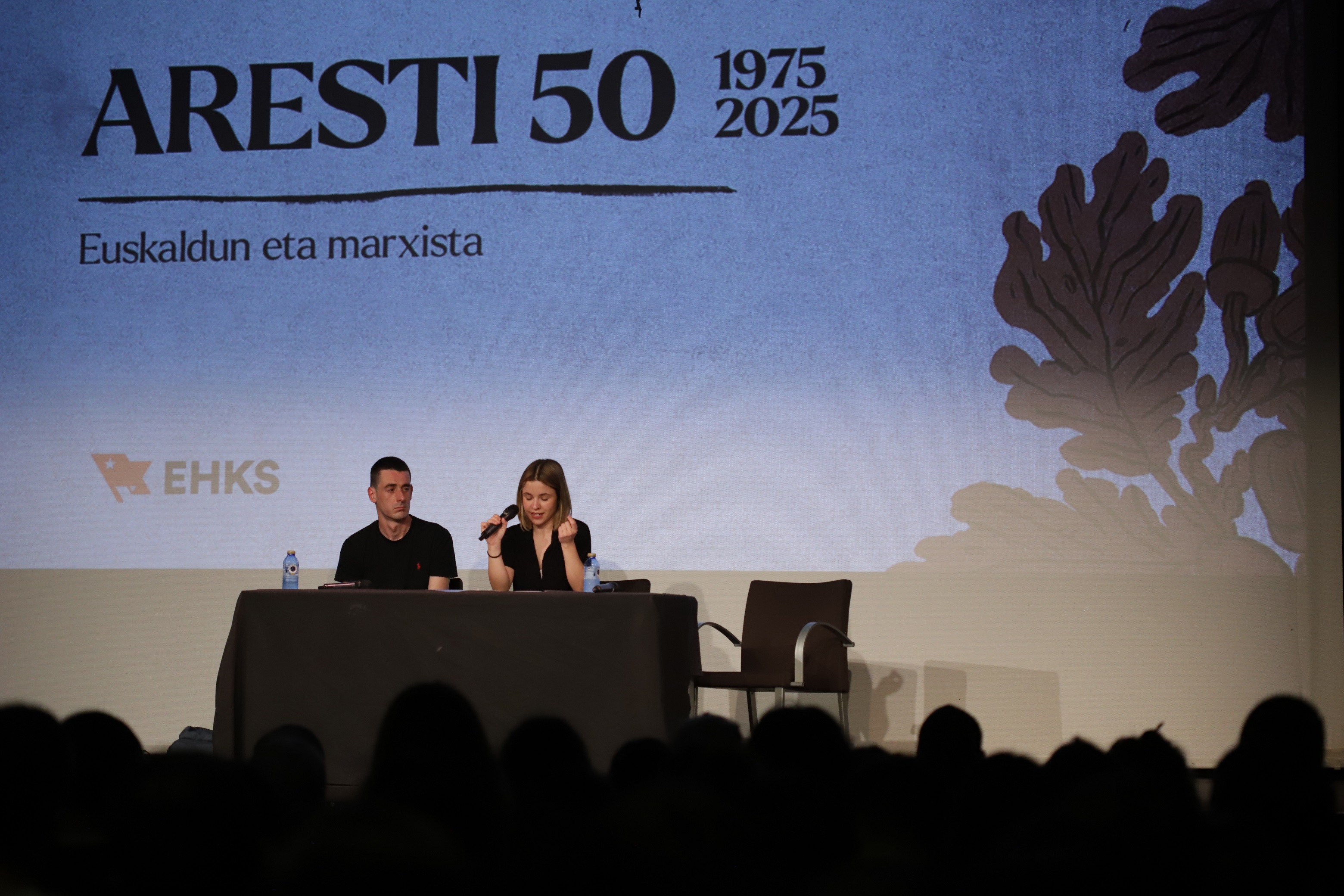Euskera is not the axis of the Government's cultural policy, but "transversal"
- The Basque Government has presented Strategic Plan Culture 2028, an 80-page document. Only real interventions in favor of creation in Basque have been collected. The document itself recognizes that “one of the most outstanding actions to promote creation is the offering of scholarships to writers who believe in Basque”. Compared to the strategy budget so far, it will be reduced by 15% by 2025.

The Basque Government has linked culture to globalisation and, therefore, to internationalisation, to digital transformation, to the climate emergency, to gender inequality and to the socio-economic values of culture in providing the first ideas for reflection on the social and cultural context. Nor do the creators working with the Basque people appear in these first guidelines. When it comes to promoting creativity and talent, yes, it is seen that, in some way, the Basque thing “needs to be boosted more”, but without raising real extraordinary initiatives. That is, what the document ultimately underlines is that, that the Basque is an “indirect commitment”. The three main axes are the extension of creative possibilities, the guarantee of prosperity and diversity of supply and the conservation and transmission of cultural heritage, which includes the renewal of the Museum of Fine Arts of Bilbao and the definition of the bases of the Guggenheim project of Urdaibai.
In addition to these axes, there are two commitments that are considered transversal: to influence equality between women and men – says that the Documentation Centre for Basque Women Artists will be created – and to influence the normalization of the Basque country.
On page 53, in the section on indirect commitments concerning Basque:
“The Basque people must pay special attention to the Basque people, both in the creation or production, as well as in the supply and transmission of memory. In the Basque Country, culture cannot be understood without Basque culture, nor without taking into account the whole Basque cultural context. At the heart of the cultural policies of the Basque Government is the guarantee of opportunities to create, live and remember the culture in Basque. In all lines of work, cultural content and services in Basque are especially encouraged”.
Market and Basque Country
Creation, supply and transmission are the three axes, as mentioned above. Contents in Basque are part of this second axis, “the commercialization and dissemination of culture must be combined with the responsibility of offering citizens a plural and diverse cultural offer”, that is, what is suggested is that content will be offered in Basque so that the offer is “diverse”. The process therefore comes the other way because it wants to be offered. But on the axis of creators, on the first axis, there is no mention of creators working in Basque.
What we want to suggest is that content will be offered in Basque so that the offer is "varied", so the process comes the other way because it will be created because it wants to offer
In short, the principle of the creative axis is summed up as “the expansion of creative possibilities, the strengthening of the environments in which the creation and the offering of means of support for creation are essential for the people who want to have a living culture and for the people who want to survive”. And then, just two paragraphs later: “the results of creative processes should be materialized or produced to become works that can be known, enjoyed, communicated, shared. Cultural products must compete in the money, care and prestige markets.”
Clearly, the first principle that should be fundamental concerns the economic circuit. And in the economic circuit, what is the place of Euskera? “We are out and they want us out,” the writer Koldo Izagirre told us in this story, Lanartea’s Laziness. Talk about the book Culture in living flesh.
“Euskadi, auzolan”
Lanartea is the Association of Professional Workers of the Basque Country, with a trade union vocation, which gathered its demands in ARGIA. And what they said, at least at a tiny point, was included in the diagnosis of the situation:
“Many dedicate part of the time to creative activity, due to the need to share it with other jobs, they are often interrupted, most work without a fixed contract. This entails great difficulties in identifying cultural activity as a profession. Consequently, these creators are not granted the social and labour rights of other workers and professionals. This is the question that will have to be resolved in the coming years (...) In order to be able to make these adaptations in regulations, the censuses of artists and creators and data on the culture of activity have claimed the need for a common methodology and criteria, even in some cases by international institutions. The difficulties in measuring creative activity and monitoring the cultural sector through data are general. And the need for this data. In our case, the Basque Observatory of Culture is our main instrument for this task”.
Youth at destination
The discursive changes are made taking into account cultural consumption and the evolution of consumption, and this is how commitments are made, of course. “One in four Basques never reads, half of the Basques never go to museums, in the theater the same, almost 60% do not use the library service… That is the area we have to gain. An increasingly important task is to make culture visible, visible and attractive, and especially to attract new audiences, especially young people”.
The Department of Education will be directly responsible for promoting cultural consumption among young people
The Department of Education will have a direct responsibility for promoting cultural consumption, especially with a focus on reading. At a time when education is also being digitised, the new plan allows us to understand that the eLibrary of the digital network will use more platforms, specifically the design of the Reading Plan is foreseen. On the other hand, it is pointed out that another plan will develop actions to “develop the art system” and enhance the activity of museums.
Euskera in the digital world
Mentioning digitalisation, the Kultura Plan 2028 also provides significant data. Prior to Pandemia, 10.4% of the population paid access to digital platforms for the visualization of audiovisuals, compared to 63.4% today.
In digital platforms it is well known that the supply in Basque is scarce, not to mention that of content created in Basque. Well, the plan envisages, in the promotion of the digital leap, the need to strengthen the presence of Basque culture in the digital environment. Three initiatives are proposed that are not further elaborated: “The creation and dissemination of digital content, with special attention to those of Euskera”. This inevitably allows the funding of the Spanish content generated in Araba, Bizkaia and Gipuzkoa compared to the Basque content.
The contents created in Euskera are matched with the contents in Spanish of the CAPV
Moreover, it is clearly stated that the initiative of the EiTB Media Group will be “decisive” in promoting audiovisual production. But beyond language, because of its content, journalist Urtzi Urkizu published last week in the Berria newspaper that EiTB does not fund several projects and that yes, if his political vision was well taken over by the Gogoratuz Institute or not.
Responsibility for cultural and media promotion
These are textual words: “For the survival of Euskera and Basque culture it is essential to increase the strength of this community, pay special attention to the Basque potential market and make visible the products of Basque culture. The media in Basque influence and have special relevance in the offer and cultural customs in Basque. Publications such as Berria, ARGIA and Jakin, or local publications, are important promoters of culture and cultural consumption in Basque. On the one hand, they are a strategic tool for the dissemination of the cultural offer in Euskera, key for the public that wants to consume in Euskera to be aware of this offer”.
The document states that the Basque media are “expressly” supported by the Basque institutions.
Obduction of Amenaza / Zirt Zart (Split-ep)
2024
---------------------------------------------------
The musical panorama is gigantic, impassable. Among them there are a few large groups that absorb all the foci; many others that are dedicated to the pursuit of it, and... [+]
Guardasol gorria
Lutxo Egia
Susa, 2024
Apirilaren 24an, ETB1ean, jendeak aspalditik eskatzen zuen programa eredu bat estreinatuko da: Linbo, late night formatuko ordubete inguruko saioa, gazteek eta gazteentzat egina.
Iruñea ez da oso handia, baina Beñat Iturbek elkarrizketarako lekua hautatu duen arte ez dut jakin institutu berean ikasi genuela. Madril eta Iruñea artean bizi da, han hemen baino gehiago, oraingoz. Etxera egin duen bisita bat probestu dut harekin... [+]
Hainbatetan esan izan didate arkitektoen lanaren gauzarik indartsuena dela ekoizten duguna betikotu egiten dela. Eraikinaren betikotasunak gizakiaren presentzia tenporala gainditzen duela eta geroko etorkizunean iraunkor egingo gaituela. Eta liburu batekin gertatzen ez den... [+]
"Ask for your turn and we'll join you," the willing and cheerful announcer who speaks from the studios tells the young correspondent who walks through the streets of Bilbao. The presenter immediately addressed the audience. "In the meantime, we are going to Pamplona..." They opened... [+]




















